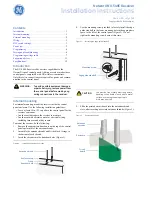
E
N
G
L
IS
H
41
• The surround back channels' power amplifier can drive the surround back speakers, the ROOM 2 speakers or the front bi-amp
capable speakers. Depending on how to use the speakers, you should assign the power amplifier correctly. (For details, refer
to "CONNECTING SPEAKERS" on page 8 and "CONNECTING ROOM 2 OUTS" on page 10.)
Surr Back
↔
Room 2 : When connecting this receiver to the surround back speakers and the ROOM 2 speakers both, the
↕
power amplifier automatically drives the surround back speakers or the ROOM 2 speakers
depending on whether the ROOM 2 function is turned off or on.
Bi AMP : To drive the front bi-amp capable speakers when connecting the FRONT and the SURROUND BACK/MULTI
↕
channels to them.
Surround Back : To drive the surround back speakers when connecting the SURROUND BACK/MULTI channels to them.
↕
Room 2 : To drive the ROOM 2 speakers when connecting the ROOM 2 channels to them.
• "Subwoofer Plus+" mode is valid only when "Front" and "Center" are set to "Full Range" and "Subwoofer" is set to "Yes" on the
Speaker/Room EQ Setup menu. (For details, refer to "SETTING THE SPEAKER/ ROOM EQ SETUP" on page 43.)
Normal : When the low frequency signals of channels set to "Full Range " are reproduced from those channels only. In this
mode, the low frequency signals that are reproduced from the subwoofer channel is only the low frequency signals of
LFE (from the multi-channel sources that contains LFE (Low Frequency Effects) channel, also called the ".1" channel)
and the channels set to the setting value other than "Full Range".
Subwoofer Plus+ : When the low frequency signals of channels set to "Full Range" are reproduced simultaneously from those
channels and the subwoofer channel.
In this mode, the low frequency range expands more uniformly through the room, but depending on the size
and shape of the room, interference may result in a decrease of the actual volume of the low frequency
range.
• The HDMI connection can carry uncompressed digital video signals and digital audio signals.
Depending on whether the digital audio signals input into the HDMI IN are output from the HDMI MONITOR OUT of this
receiver or not, you should set the HDMI Audio Output correctly.
Speaker : Not to output the HDMI digital audio signals from the HDMI MONITOR OUT of this receiver, meaning these signals
↕
are heard from the speakers connected to this receiver.
HDMI Passthrough : To output the HDMI digital audio signals from the HDMI MONITOR OUT, meaning these signals are heard
from the speakers of your TV.
■
Note:
• When the HDMI Audio Output is set to HDMI Passthrough, no sound will be heard from the speakers connected to this
receiver (except ROOM 2 speakers) even though any input source is selected.
On : To adjust the tone for your taste. ("DIR" goes off.)
↕
Off : To listen to a program source without the tone effect. ("DIR" lights up.)
■
When adjusting the tone (
Bass and Treble
)
• You can adjust the tone only when the Tone Control is set to On.
①
Press the CURSOR UP/DOWN buttons to select the desired tone, then press the CURSOR RIGHT button to
enter its setting menu.
②
Press the CURSOR UP/DOWN buttons to adjust the selected tone as desired.
• The tone level can be adjusted within the range of -10 ~ +10 dB.
• In general, we recommend the bass and treble to be adjusted to 0 dB (flat level).
• Extreme settings at high volume may damage your speakers.
Continued
↕
When selecting the AmP Assign
When selecting the Subwoofer mode
When selecting the HDmI Audio Output
When selecting the Tone Control
RD-8504(G)_ENG_091217:RD-8504(G) 2009-12-21 오 11:36 페이지 41
















































